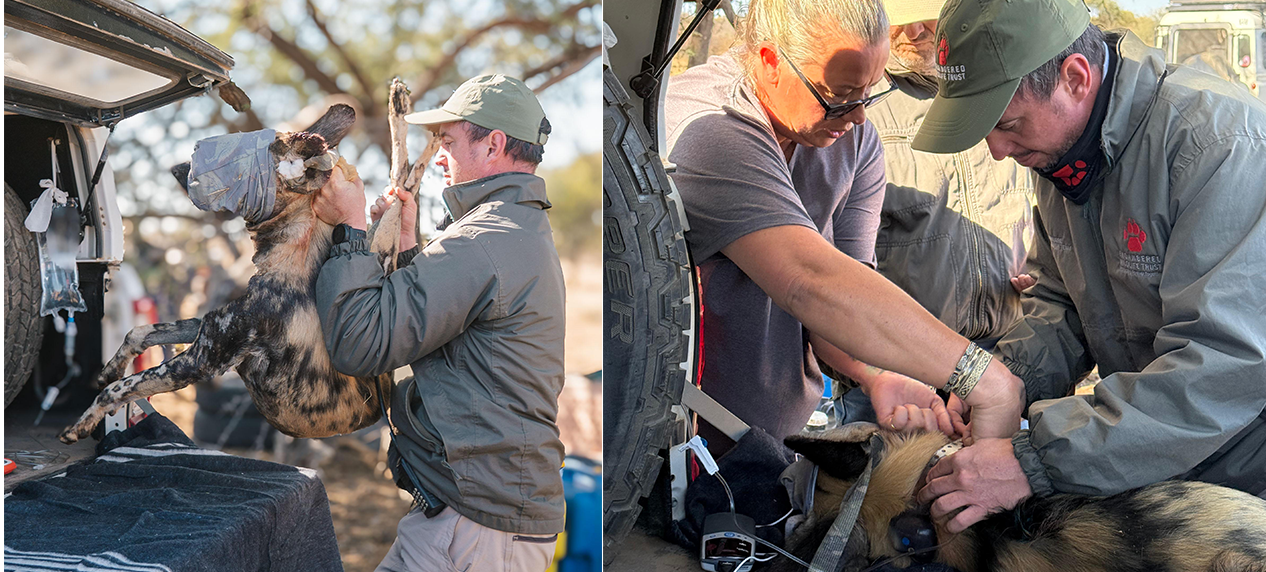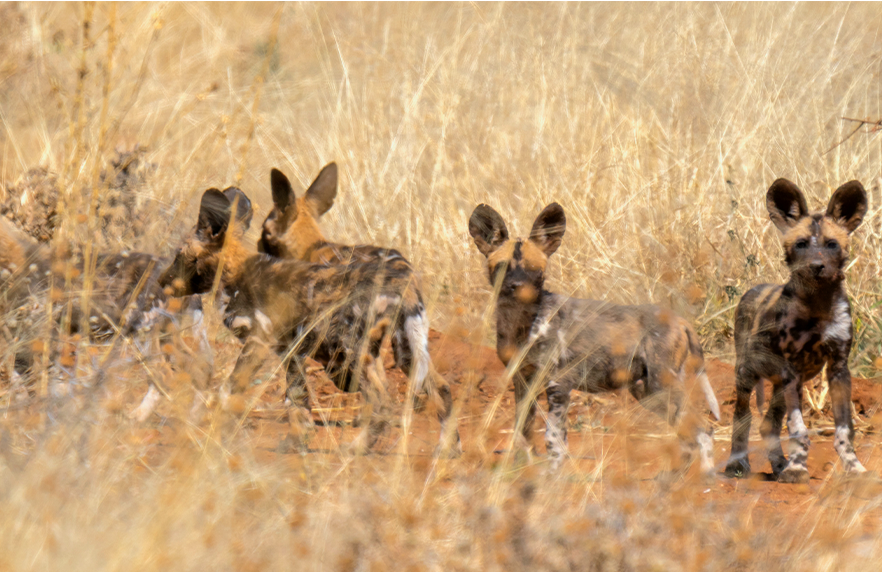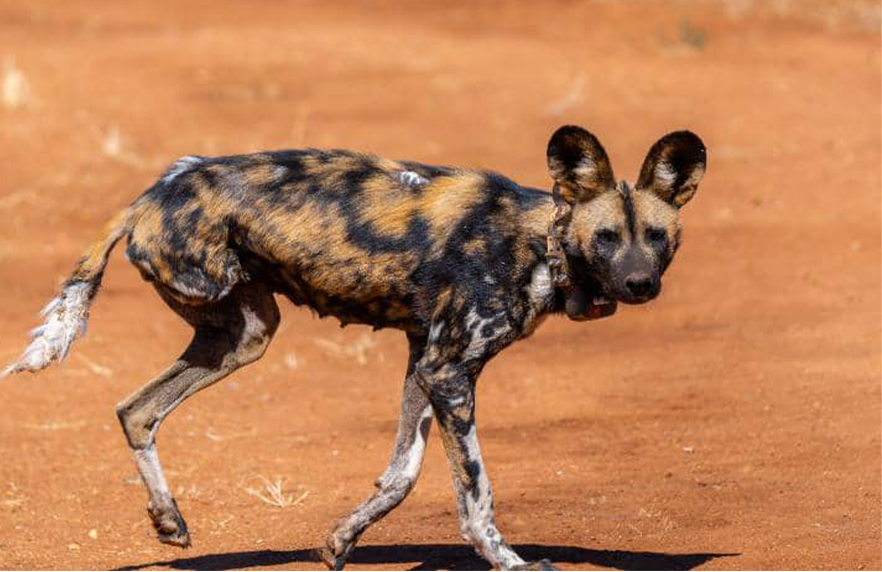An African Wild Dog rescue mission that ignited Wild Dog Conservation in Namibia.
By Cole du Plessis, Project Manager: Carnivore Range Expansion Project

Relocating (left) and Collaring (right)
Working in the world of conservation is not easy. Almost on a daily basis, we deal with animal welfare, multiple stakeholders, wide-ranging philosophies (and sometimes egos), legal requirements, decision-making processes, and the continuous urgency to fundraise in order to achieve high-impact results. The admin and emails slot in between these demands.
When we were travelling back from Botswana following a 24-hour African Wild Dog capture and relocation, we passed through the Martin’s Drift border post. It had been an intensive stint that involved hours of driving. We were relieved to be back in South Africa and looking forward to some time to rest and recover, but the world of Wild Dog conservation had other plans.
In the weeks leading up to the Botswana mission, I had been in touch with the Kalahari Wild Dog Project—a new and emerging organisation working in Namibia. They had informed me of a Wild Dog that had been captured in a gin trap set out by a farmer. Having been alerted to the situation, the team had immediately travelled to the farm where this Wild Dog had been captured, fully expecting to have to euthanise it on arrival. But it wasn’t that simple.
Upon investigation, the team learned that the Wild Dog had, for three days, been contained in a cage outside a workshop area where there was a continuous flow of trucks and people. For a wild animal, this is nothing short of agonising.
To end the suffering, the veterinarian quickly immobilised the Wild Dog. A closer inspection revealed that the captured animal was a female—and she was lactating! This drastically changed the whole scenario, requiring not only the immediate treatment and relocation of the female to a clinic a few hours away, but also finding her pups.
Nadja le Roux, the founder of the Kalahari Wild Dog Project, phoned me and provided me with an update. In my time working with Wild Dogs, I have experienced some horrific physical injuries. However, my findings have shown that it is often emotional stress that takes the greatest toll on a Wild Dog. Physically, they are tough, but separate the individual from its pack, and it becomes weak.
This socially complex species suffers from ‘broken heart syndrome’. All our conservation efforts in dealing with Wild Dogs factor in this crucial detail. This is the reason that their emotional sensitivity has been incorporated into our Standard Operating Procedures, and the findings have been documented.
The gin trap had gripped the Wild Dog on her back leg. Her cold foot and zero sensitivity between the pads indicated that she had lost the use of her leg, and infection was already setting in. The leg needed to be amputated. She also had a cracked rib.
When Nadja called me for advice, I was less concerned about the physical injuries than the dehydration and stress she was suffering. Every effort and available physical aid would be required to save this Wild Dog—fluids, antibiotics, anti-inflammatories, and warmth. It was touch-and-go, and if she did survive, the next steps would be complex. At this point, this female needed her pack to survive as much as they needed her to ensure their own survival.

Image credit: Be Wild
Though it had by then been four days without Mom, there was a chance that the pups were still alive. Returning her to where she had been captured was also not considered wise. It was then decided that the only way forward was to release her with a tracking collar and convince the farmer that this would provide us enough intelligence so the whole pack could be captured and removed to the safety of a suitable habitat. This would be done on condition that the farmer would remove his gin traps and potential poison. He obliged and agreed to allow the Wild Dogs the freedom to roam, but only for a short period.
Following surgery, the Wild Dog was released running around two kilometres before settling down. Everyone waited in anticipation, wondering whether she was going to die or whether she had been reunited with her pack.
When Nadja returned to the area a few days later to survey the area using a drone, she found the female alive, with two other adults and what appeared at the time to be six pups. It was a miracle.
After two weeks, the farmer was losing patience and one of the adult Wild Dogs had disappeared. This raised concerns that the female would have to leave her pups to go hunting with the pack. This was when Nadja called me for assistance.
Less than 24 hours later, I was on a flight to Windhoek. A three-hour drive later, Nadja introduced me to the team comprising Namibian Government Officials, members of the Kalahari Wild Dog Project and the Cheetah Conservation Fund, veterinarians, a wildlife helicopter pilot and several volunteers. After a briefing, we prepared to capture and move the adults and retrieve the pups the next day.
The aim was to move this pack to safety, away from threats such as gin traps, poisoning and snaring in a cattle farming area where conflict with people was inevitable.
This particular pack had had very little exposure to humans, and their den site was inaccessible. Because of their fear of vehicles, we opted to build a hide near the den and attempt to lure them in with ‘hoo’ calls and a carcass. But, this didn’t work. So, we decided to dart them from a helicopter. Within an hour, the Alpha male and female had been darted and secured, loaded into crates, and taken to the selected sanctuary. We then needed to focus on the pups, which appeared to be between six and eight weeks old.
Locating the pups proved to be a challenge. After hours of excavating at the site where we had spotted the Alpha pair the night before, we realised that the pack may have moved during the night to a spot where we had earlier darted the Alpha female.
That was when we stumbled upon several pups lying outside their new den. Frightened by our presence, they disappeared into a nearby hole. Careful excavation was once again underway. It was a slow, tiring and gruelling task which became ever more difficult and dangerous as the tunnels deepened, and darkness fell. But by 11 pm, we had retrieved all the pups, eight in total, and had immediately taken them to the boma four hours away.
When we arrived at the sanctuary, we found that the two adults were doing well. But, given how cold it was, it was decided that the pups’ crate needed to be taken to my room until sunrise. At daybreak, we loaded the pups and the adults and took them to the boma, where the pups were placed into an artificial den (with sand from their old den and grass from their crates) before releasing the adults. The two adults and all the pups survived the mission. A live camera at the den has confirmed that the adults are feeding and bringing food back to the pups.
A hearty development during the rescue has been the change in the farmer’s outlook about Wild Dog after he voluntarily came to help the team locate and capture the pups.
Thank you to the wonderful Kalahari Wild Dog Project team, who never gave up on that little pack. Just this one critical experience has given rise to multiple major wins for conservation. These include:
- The survival of a heroic female Wild Dog and the rescue of her pack, which were saved from certain death.
- This was the first capture of its kind in Namibia. The operational team, initially quite sceptical of whether the capture would work, were left feeling very excited, and we all learned and gained from this shared experience.
- This was a collaborative operation with multiple Namibian partners eager to learn and contribute.
- The Namibian government has indicated that it wants to do more for Wild Dog conservation and has promised representation at the Wild Dog Advisory Group.
A workshop is being held with numerous stakeholders to discuss the conservation and management of Namibia’s Wild Dogs, with some exciting initiatives on the table.
The team sent the farmer photos of the release, and he has asked for the final video so that he can showcase it to his farming community. This is possibly the biggest win of all, as knowledge and understanding of our wildlife and the critical role that they play in our world is essential to their survival through the generations.

** Thank You to the Painted Wolf Foundation for your support
